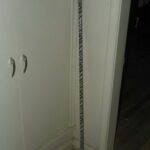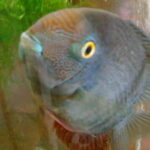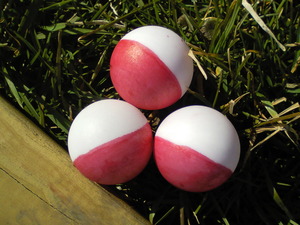Raising Convict Cichlids is a fun and rewarding hobby. Convicts are a type of South American Cichlid also known as Archocentrus nigrofasciatus. They are distant relatives of piranhas! You may know of a closer aquarium cousin called the Oscar.
Convicts grow to be several inches long, and as adults they look something like a zebra. These distinctive “prisoner” stripes gave rise to the name. The most common sort of convict is gray with black stripes, but there are also pink convicts available. Females often have a deep red belly that grows redder right before she lays eggs.
If you plan on keeping a convict and not breeding, it’s best to have a lone convict in an aquarium with other cichlids. If you plan on breeding, it’s best to have two male and two female fish in a tank with only convicts. Convicts will pair off and breed with one mate for life.
Convict Cichlids need plenty of room to establish a territory when they breed. Some aquarists say that a 55-gallon tank is almost too small for two convicts, but we haven’t found that to be the case. We currently have two housed in a 10-gallon aquarium with their fry (babies), and eight more in a 35-gallon tank (with babies). We do have to perform frequent water changes, but they seem to be happy, healthy fish.
One thing convict cichlids like to do is re-arrange their tank. Use a small gravel when you set the tank up. They’ll spend much of the day picking up pieces of gravel and moving them to a new place. You should also make them some “caves” with rocks, aquarium decorations, or new clay flower pots (unglazed only, scrub with salt water and bake on low temp to kill all germs). They also like floating plants to hide in.
If you are establishing a new tank, you should fill the tank with water, treat it, and let it run for several days before adding fish. If you’ve never had a tank before, invest fifty cents in a few guppies or feeder fish and practice with them for a few weeks before purchasing convicts. Learn what the “cycle” is and how to maintain water chemistry before you go further.
If you are adding a lone convict to an established tank of other cichlids, it’s usually better to remove the other fish and let the convict have the tank to himself for a little while. Then add the other fish back in. It’s not uncommon for a convict to lose its color when you introduce it to an aquarium or if it gets stressed. In fact, if your convict fades out in an established tank, it’s time to check your water chemistry.
Convicts, like all cichlids, can be quite aggressive when threatened. You’ll need to watch your tank to be sure your little guy isn’t attacking (and hurting) your larger fish. You also need to use care when performing tank maintenance. They may have small mouths but a frightened fish can nip. It’s not likely they’ll hurt you, but you might hurt your fish accidentally, trying to get away from him!
Convicts like to eat just about everything you’ll feed them. We use flakes made for convicts, supplemented by thawed frozen peas and a special frozen fish cube made especially for cichlids (you can buy it at most aquarium supply stores).
To breed convicts, you need several things. Water, a tank, and a male and female fish. It helps to have a “cave” where the female will feel safe to lay her eggs. It also helps to have the temperature at an even 80-82 degrees and the water chemistry “just right”. However, ours have bred with the temperature at 70 degrees and the ph lower than they like and the ammonia reaching toxic levels!! The eggs and fry did just fine! However, we have noticed that when temps are lower, it takes longer for the eggs to hatch.
When the female goes to lay her eggs, she’ll look for (or make) a smooth surface. The eggs look like tiny yellowish dots. They usually hatch within 3-5 days. The parents take turns “fanning” the eggs with their fins, and aggressively keep watch over them. They’ll bite another fish who comes near!!
Once in a while, eggs will be eaten – usually by the parents. If this happens once, don’t worry. If they do it repeatedly, check for stressors like a cat, a water change, other fish, or bad water chemistry.
The eggs will hatch into “wrigglers”. If you’ve never seen them before, they look like moving dirt. You really can’t tell they’re fish but if you squint you can almost make out eyes!! The parents will hover over them, fanning them. Don’t try to move them into a net or tiny aquarium, or separate them from the parents. Convict parents are GOOD parents and they will freak out if you kidnap their children!!
Eventually the wrigglers grow into free-swimming fry. They will eventually start to eat finely crushed flakes, but take care not to over-feed the tank!! If you are using a power filter, it may be necessary to cover the end of the suction tube with a nylon stocking, so the babies don’t get sucked into the filter.
Don’t be surprised to see the parents picking the wrigglers or fry up in their mouths. Often, they’re just moving them. Picture a mom and dad on a playground with 100 active toddlers running everywhere!! Surely one will get swallowed once in a while by accident, but don’t worry too much. Don’t worry if they all of a sudden disappear and you can’t find any babies anywhere!! This has happened to us twice, and both times the babies were back the next day. We’ve never figured out where they’re hiding!
You can keep the babies for yourself, but consider – where will you put 100 three to four inch fish? It’s often better to find good homes for them. Some pet stores will buy baby convicts. You can also advertise in the paper, or give them away. They’re usually ready to go at 1 to 1.5 centimeters. Be sure you’re giving them to “parents” who will take good care of them!





